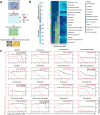High-throughput screening unveils nitazoxanide as a potent PRRSV inhibitor by targeting NMRAL1
- PMID: 38844461
- PMCID: PMC11156899
- DOI: 10.1038/s41467-024-48807-y
High-throughput screening unveils nitazoxanide as a potent PRRSV inhibitor by targeting NMRAL1
Abstract
Porcine Reproductive and Respiratory Syndrome Virus (PRRSV) poses a major threat to the global swine industry, yet effective prevention and control measures remain elusive. This study unveils Nitazoxanide (NTZ) as a potent inhibitor of PRRSV both in vitro and in vivo. Through High-Throughput Screening techniques, 16 potential anti-PRRSV compounds are identified from a library comprising FDA-approved and pharmacopeial drugs. We show that NTZ displays strong efficacy in reducing PRRSV proliferation and transmission in a swine model, alleviating viremia and lung damage. Additionally, Tizoxanide (TIZ), the primary metabolite of NTZ, has been identified as a facilitator of NMRAL1 dimerization. This finding potentially sheds light on the underlying mechanism contributing to TIZ's role in augmenting the sensitivity of the IFN-β pathway. These results indicate the promising potential of NTZ as a repurposed therapeutic agent for Porcine Reproductive and Respiratory Syndrome (PRRS). Additionally, they provide valuable insights into the antiviral mechanisms underlying NTZ's effectiveness.
© 2024. The Author(s).
Conflict of interest statement
The authors declare no competing interests.
Figures






Similar articles
-
Antiviral activity and underlying mechanisms of baicalin against porcine reproductive and respiratory syndrome virus in vitro.Microb Pathog. 2024 Aug;193:106712. doi: 10.1016/j.micpath.2024.106712. Epub 2024 Jun 7. Microb Pathog. 2024. PMID: 38851360
-
Chlorine dioxide inhibits the replication of porcine reproductive and respiratory syndrome virus by blocking viral attachment.Infect Genet Evol. 2019 Jan;67:78-87. doi: 10.1016/j.meegid.2018.11.002. Epub 2018 Nov 3. Infect Genet Evol. 2019. PMID: 30395996
-
Isobavachalcone inhibits post-entry stages of the porcine reproductive and respiratory syndrome virus life cycle.Arch Virol. 2018 May;163(5):1263-1270. doi: 10.1007/s00705-018-3755-4. Epub 2018 Feb 6. Arch Virol. 2018. PMID: 29411137 Free PMC article.
-
Mechanism of PRRSV infection and antiviral role of polyphenols.Virulence. 2024 Dec;15(1):2417707. doi: 10.1080/21505594.2024.2417707. Epub 2024 Oct 21. Virulence. 2024. PMID: 39432383 Free PMC article. Review.
-
Antiviral Strategies against PRRSV Infection.Trends Microbiol. 2017 Dec;25(12):968-979. doi: 10.1016/j.tim.2017.06.001. Epub 2017 Jun 23. Trends Microbiol. 2017. PMID: 28652073 Review.
Cited by
-
METTL3 regulates PRRSV replication by suppressing interferon beta through autophagy-mediated IKKε degradation.J Virol. 2025 Jul 22;99(7):e0009825. doi: 10.1128/jvi.00098-25. Epub 2025 Jun 23. J Virol. 2025. PMID: 40548751 Free PMC article.
-
The commercial PRRSV attenuated vaccine can be a potentially effective live trivalent vaccine vector.Appl Microbiol Biotechnol. 2025 May 2;109(1):109. doi: 10.1007/s00253-025-13502-5. Appl Microbiol Biotechnol. 2025. PMID: 40316839 Free PMC article.
-
Lycopene Inhibits PRRSV Replication by Suppressing ROS Production.Int J Mol Sci. 2025 Aug 5;26(15):7560. doi: 10.3390/ijms26157560. Int J Mol Sci. 2025. PMID: 40806687 Free PMC article.
-
Inactivated Rothia nasimurium promotes a persistent antiviral immune status in porcine alveolar macrophages.Front Immunol. 2025 Jun 3;16:1584092. doi: 10.3389/fimmu.2025.1584092. eCollection 2025. Front Immunol. 2025. PMID: 40529370 Free PMC article.
-
Antiviral activity of nitazoxanide against pseudorabies virus infection in vitro.Front Vet Sci. 2025 Jun 16;12:1623545. doi: 10.3389/fvets.2025.1623545. eCollection 2025. Front Vet Sci. 2025. PMID: 40589730 Free PMC article.
References
-
- Keffaber, K. K. Reproductive failure of unknown etiology. Am. Assoc. Swine Pract. Newsl.1, 1–9 (1989).
-
- Baron T, et al. Report on the first outbreaks of the porcine reproductive and respiratory syndrome (PRRS) in France. Diagnosis and viral isolation. Ann. Rech. Vet. 1992;23:161–166. - PubMed
MeSH terms
Substances
LinkOut - more resources
Full Text Sources
Other Literature Sources
Miscellaneous

